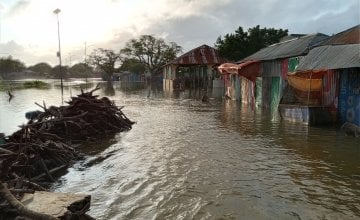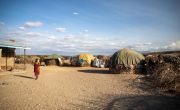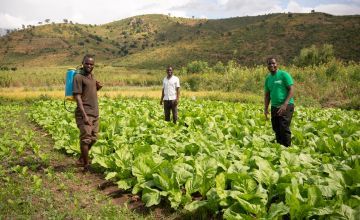
Read our 2023 annual report

Knowledge Hub
In recent years, there has been a growing awareness of the impact that climate change is having on communities and a strong desire to make a stand to protect the most vulnerable.
During this time, climate change resilience has developed as an approach that can help turn the tide in the fight against climate change.
Here we explain how climate change resilience can protect those who are most impacted by the effects of climate change, and how we can all do our part to support those most at risk.
What is the definition of climate change resilience?
Climate change resilience is the ability to prepare for, withstand, and recover from the challenges presented by climate change.
What are climate stressors?
Climate change is making extreme weather events more frequent and intense, as well as changing the timing and location of these events. These factors, or climate stressors, can also result in slower onset impacts such as gradual sea rise.
Here are examples of four climate stressors:
- Droughts – increased frequency of droughts has meant that the number of undernourished people in drought-sensitive countries has increased by over 45% since 2012.
- Floods – crop damage and destruction is the most critical negative impact of flooding, followed by shelter damage and destruction, and disruptions in access to healthcare and education facilities.
- Strong winds – winds that accompany events such as storm surges and cyclones can devastate infrastructure and lead to the displacement of families.
- Sea level rise – this threatens to affect communities in over 570 coastal cities by 2050. In that same time period, it is estimated that as many as one billion people could be displaced due to rising sea levels.

How do you build a climate resilient community?
Communities themselves are the most aware of the risks, priorities and strengths. For this reason, we work closely with communities and take a collaborative approach to support them in increasing their resilience to climate-related events.
Some of these steps include:
Assessing the ways in which a community may be at risk. Each community faces its own unique climate change related challenges. Identifying which challenges and the likelihood of their occurrence is a crucial first step in how to build resilience to climate change.
Developing a community resilience plan. A good community resilience plan should help mitigate the risks identified in step one, while also outlining steps for recovery in the event of a climate disaster. Crucially, a good community resilience plan will identify those most vulnerable to climate change shocks and will include the necessary provisions to safeguard their well-being.
Implementing the community resilience plan. Whether it is through advocating with local authorities or working collaboratively with at-risk communities, Concern works to meet our commitments to those most in need once a plan is in place,
What is a community resilience plan?
A community resilience plan is a plan of action that outlines guidelines for preventing disaster impacts, preparing for those which can't be prevented, and looking at ways to aid recovery. A community resilience model should be integrated into all other forms of community planning, to ensure communities are as prepared and adaptable as possible in the face of increasingly frequent challenges.
What are examples of climate resilient planning?
Concern has an organisational commitment to reaching 600,000 farmers with climate smart agriculture interventions and currently implements agriculture livelihoods activities in a variety of climates across Africa and Asia.
In the case of the former, this includes the hot, semi-arid Sahel, Horn of Africa, and Rift Valley regions (Niger, Chad, South Sudan, Sudan, Ethiopia, Somalia, Kenya, Malawi), the cool Central African highlands (Democratic Republic of the Congo, Burundi, Rwanda), and the humid tropics of West Africa (Liberia, Sierra Leone).
The diversity of the areas where we carry out this work is just as striking; from the hot Indus Plains of Pakistan, to the monsoonal coastal area of Bangladesh, and the temperate, mountainous regions of the Democratic People’s Republic of Korea and Afghanistan.
Additionally, Concern is committed to working collaboratively towards the achievement of the Sustainable Development Goals (SDGs). The link between sustainable development and limiting global warming to 1.5°C is recognized by the SDG for climate action (SDG 13) and protection of the environment is an essential element of all of the goals, including commitments to end hunger and extreme poverty.
As you can see from the above, the approaches to climate resilience are very diverse. However, Concern has a commitment to climate-smart agriculture, and recognises that protection of the environment is an essential element of sustainable development.
Our climate resilience work goes beyond climate-smart agriculture to livelihoods work, markets and social protection and disaster risk reduction.


What are examples of climate resilience?
A great example of climate change resilience in action can be seen in our work in Bangladesh. Bangladesh is one of the most climate-vulnerable countries in the world. The country is experiencing erratic rainfall patterns and an increasing occurrence of natural disasters including floods, cyclones and tidal surges. So we have taken the lead in an alliance that has been formed to reduce the impact of floods on people and increase the ability of communities to thrive.
We have found that nature-based solutions are designed to address major societal challenges, such as food security, climate change, water security, human health, disaster risk, social and economic development. Based on findings of a long term study, Concern will be advocating for a shift away from ineffective projects such as expensive levee construction, in favour of community-managed, less costly and more effective natural solutions.
This isn’t the only way that Concern is helping communities in Bangladesh to build their resilience towards climate change. The Coastal Community Resilience project works with 6,000 households in 140 communities to build their resilience by introducing and promoting climate adaptive livelihood practices.
The project enables communities to assess their risks and develop risk mitigation plans. It also supports community leadership to mobilise local resources, and to strengthen systems of disaster to address local issues. By working with local government, the project has been able to influence authorities to highlight local issues at national-level planning forums, ensuring that those most vulnerable get the help that they need.

Climate change and resilient agriculture
The Sahel, a region which divides the Sahara desert from the tropical savannas to south, has been identified as severely at risk from the effects of climate change.
Most livelihoods in the Sahel are highly dependent on rain-fed agriculture and pasture for livestock. Increasingly erratic climate patterns, a rise in temperatures, and more frequent extreme weather events have been witnessed across the Sahel. By promoting Climate Smart Agriculture in the Sahel, we are helping to increase vulnerable people’s capacity to adapt their food production to these effects of climate change which is vital to increasing their food security and resilience.
This might involve changing and diversifying crops to better adapt to a changing environment and associated risks, harvesting rainwater or keeping soil covered with organic matter to keep moisture in. Ultimately, Climate Smart Agriculture can sustainably increase the amount of crops that a community can produce safeguarding vulnerable people both today and for the future.
Climate change and community resilience
Our approach to building community resilience puts local people at the centre of identifying and tackling the range of risks they face. Climate impacts affect women, men, girls and boys differently, and gender and societal norms mean that women tend to bear the brunt of the impacts. For this reason, it's key that we tailor our activities to address this.
Our programmes around Climate Smart Agriculture involve working with poor farmers to better use and manage natural resources and adopt more efficient methods of producing, processing and marketing agricultural goods).
This approach presents farmers with the opportunity of a ‘triple win’:
• Enhanced food security by sustainably increasing the reliability and productivity of agricultural livelihood activities
• Increased smallholder resilience and adaptation to the likely effects of climate change
• Where appropriate, and in the interest of smallholder farmers, reduced greenhouse gas emissions from agriculture and improved carbon sequestration.
In 2020 alone, we reached 210,756 farmers (81,891 male and 128,865 female) with CSA related interventions. This, combined with the previous four years’ activities, means that we've supported a total of 780,127 individual farmers so far.

Why is climate change resilience important?
Combatting climate change is one of the greatest challenges we have ever faced as a species. Building climate change resilience is crucial and needs to be prioritised by governments. High-income countries need to deliver on their commitments to low-income countries to make sure that the people most vulnerable to climate change receive the support they need.
In our fight against climate change, climate change resilience is crucial as:
- It helps break down the gargantuan task of coping with climate change into straightforward actionable goals.
- It allows us to greatly reduce the detrimental impact of increasingly frequent climate-related disasters.
- It helps to protect those most vulnerable to the effects of climate change from food insecurity.
- It necessitates the implementation of sustainable methods which can help avoid further increase in the global temperature and bring us closer to achieving the Sustainable Development Goals.
Find out more
If you would like to learn more about how you can help in the fight against climate change, check out our suggestions below.




